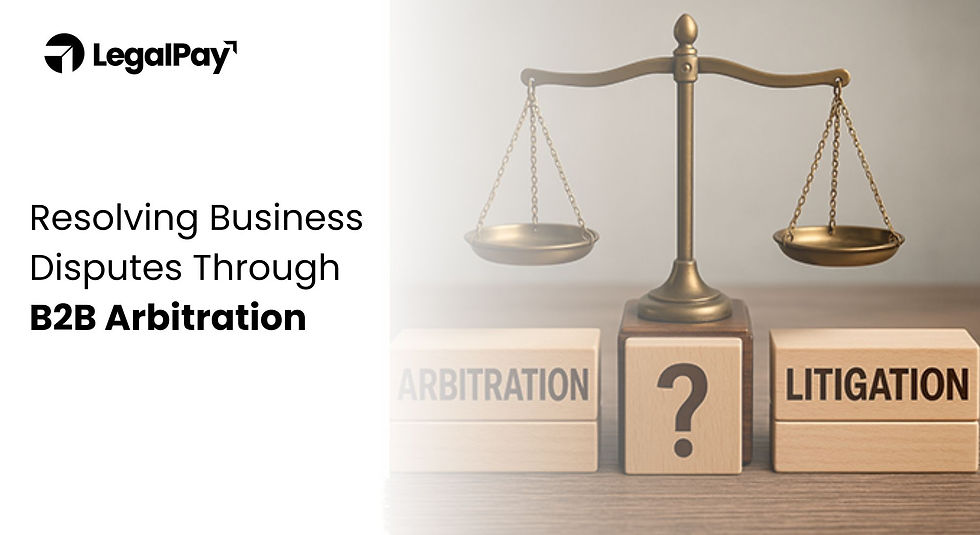ESG and Litigation Financing in India
- LegalPay

- Sep 12, 2022
- 6 min read

An Overview
Third-party litigation financing is a recourse to ‘access to justice.’ It is a more financially viable route through which individuals and businesses under financial distress can pursue their legal remedy. The existence of an external litigation funder sends a strong message to the opposite party that the funded party has done a proper analysis of his case and has formulated a sound legal strategy based on the merits and demerits of the matter to seek a reasonable recompense. Continue reading to know more about ESG and Litigation Financing.
ESG norms
SEBI Regulations on ESG
The Securities and Exchange Board of India (SEBI) introduced the requirement of ESG (environmental, social, and governance) reporting back in 2012 and mandated that the top 100 listed companies by market capitalization file a Business Responsibility Report. This was later extended to the top 500 listed companies by market capitalization in 2015. On 10th May 2021, the SEBI introduced a new ESG reporting structure by the name Business Responsibility and Sustainability Report (BRSR).
Under BRSR, listed entities (top 1000) need to provide an overview of the entity's material ESG (environmental, social, and governance) risks and opportunities, approach to mitigate or adapt to the risks along with financial implications of the same. BRSR was introduced with the aim of making it mandatory for the top 1000 listed companies to report their sustainability performance to maintain transparency with stakeholders.
International covenants on ESG
In a cohort with the Paris Agreement, signatory countries must ensure that registered companies under their national laws must improve their Environmental, Social, and Governance (ESG) performance. As a result, investors are preferring companies that prioritize Paris Agreement’s objectives in the context On 10th May 2021, the SEBI introduced a new ESG reporting structure by the name Business Responsibility and Sustainability Report (BRSR). of their ESG concerns and climate change actions.
One of the requirements for signatories to fulfil under Article 4 of the Paris Agreement, 2016 is reproduced herein:
“Parties shall account for their nationally determined contributions. In accounting for anthropogenic emissions and removals corresponding to their nationally determined contributions, Parties shall promote environmental integrity, transparency, accuracy, completeness, comparability, and consistency, and ensure the avoidance of double counting, in accordance with guidance adopted by the Conference of the Parties serving as the meeting of the Parties to the Paris Agreement.”
Class-action suits for ESG norms violation
Violation of ESG compliance usually leads to companies being sued by way of class action suits. At its very core, it may be argued that a class action suit is a modified version of public interest litigation. The class action suit was an ‘Invention of Equity’ arising out of the Bill of Peace 11 of the United Kingdom which allowed English courts to bring together multiple claims related to the same cause of action, within a common legal proceeding. The two primary reasons justifying the use of the class action device are as follows:
The multiplicity of actions must be avoided; time and energy are saved as a large and unmanageable number of person club and join their grievances in a single suit; and
Law provides a right to get redress against the wrongs that are not worth pursuing individually
Case Study on ESG
Gross Mismanagement and shareholder’s rights: Satyam computer case
One such prominent Indian example is the Satyam case where there was no provision in the Indian legal system for a class-action suit. Various investors approached the National Consumer Dispute Redressal Commission (NCDRC) and then the Supreme Court of India to pursue securities class action suits, but their claims were rejected because of the reason that there are no relevant laws in place in India to deal with class action suits. However, the investors of the company in the United States who moved the court seeking redressal were awarded a sum of 125 million dollars as compensation due to the efficient class-action system. Satyam Scam led to the introduction of section 245 in the Companies Act, 2013 empowering the creditors of any class to club all their claims under the class-action suit.
The problems which arose concerning class-action redressal against Satyam Computer under the Indian legal system were as follows: -
After the fall in the share prices of Satyam computer due to financial mismanagement of the company, there was no recourse for the shareholders to compensate for their shareholding value. The share prices fell from Rs 304.80 on the 31st of November 2008 to Rs 54.05 on the 31st of January 2009. The SEBI regulations of 1992 were only limited to enforcing securities regulations against the board.
The shareholder’s claims along with Midas Touch, a consumer protection organization were rejected at both NCDRC and the appellate stage of the Supreme court for lack of an extant law dealing with collective actions against companies.
Due to a lack of collective-action-based legal oversight, auditors who were believed to be complicit in the auditing fraud could not be held liable or accountable for financial misstatements in the books of accounts. Satyam drew significant revenue from PWC and who were later, also appointed their auditors, who might have given them favourable accounting treatment. They were allegedly said to have accepted the claims of their client at face value without even minimal checks, in a bid to retain their high-income clients. Under the erstwhile Companies Act, 1956, auditors were engaged by companies and shareholders had no privity with the auditors. Consequently, no claim could be raised by Indian shareholders against the auditors of Satyam.
While Indian shareholders and investors suffered due to the lack of a provision for class action suits, the interests of their counterparts in the United States were safeguarded by a settlement of $125 million from Satyam and $25.5 million from PwC. The US allowed investor fraud allowed a swift justice delivery to its foreign investors. In the case of Satyam Computer Services Ltd. Securities Litigation, a sum of $125 million was paid as the settlement by Mahindra Satyam to United States investors who held ADRs because the erstwhile promoters of the company admitted to fraud. Tech Mahindra, which subsequently took over Satyam, was required to settle all pending litigations with several investors who had claimed losses due to the shares of the firm plunging on the stock exchanges.
It is now well within the rights of the shareholders under ESG compliance requirements to demand answers or specific action, including change or compliance with more stringent corporate governance policies. Activism can take several forms, including proxy shareholder battles, publicity campaigns, shareholder resolutions, etc. This has led to a more dynamic interaction between ordinary shareholders and management/promoter groups.
Endangering public health: Nestle Maggi ban
In 2015, a class action suit was initiated by the Government of India under section 12(1)(d) of the Consumer Protection Act, 1986 in NCDRC (National Consumer Disputes Redressal Commission) against Nestle India Ltd4. The complaint was filed as a collective action on behalf of consumers when the Food Safety and Standards Authority of India (FSSAI) found higher levels of lead in its instant noodles sold under the brand name ‘Maggi.’ The claim seeks damages amounting to Rs 640 crore for alleged unfair trade practices, false labelling, and misleading advertisements. The case is still pending in the courts. However, it has opened doors for more collective actions. These categories of claims, although did not involve violation of any ESG norms, further strengthen the notion that ESG norms impute responsibility on food companies risking public health standards for windfall profits.
Conclusion
Firstly, with investment in precarious and long-drawn legal battles or even rather, short-term arbitrations, there comes a sure risk of losing money. In the US, law firms and lawyers act as catalysts and ask the affected parties to file the case. This is because they get a share from the compensation and the aggrieved parties need not pay any for the legal assistance sought. This is possible because in the U.S. lawyers are allowed to charge contingency fees, i.e., the lawyer gets his fee only if the case is won. In India, the Bar Council of India prohibits advocates from accepting contingency fees.
Since 1st April 2013 contingency fees, or damages-based agreements (DBAs), have been permitted for contentious work (i.e., litigation or arbitration proceedings) in England and Wales. This means that lawyers can conduct litigation and arbitration in this area in return for a share of any damages.
Secondly, the Investor Education and Protection Fund cannot be allowed to be used under section 245 of the Companies Act, 2013 because of a high probability of misuse.
Thirdly, in the USA, all class action suits are financed are a result of third-party funding. The financial side of litigations has always been a major concern in India. For example, stamp duty and court fee legislation in every state, such as the one in Delhi requires that the plaintiff shall pay up to 4% of the total claims upfront. This would make most class action suits economically unsustainable to pursue.
Fourthly, unlike in the UK, which has a code on litigation funding within which exceptional circumstances exist under which funders reserve the right to terminate the funding agreement namely,
If the funder ceases to be satisfied with the merits of the dispute;
If the funder believes that the dispute is no longer commercially viable; or
If the funder believes that there has been a material breach of the funding agreement by the litigant, protections afforded to litigation funders do not exist under Indian laws.
It only remains to be seen as and when ESG norms receive enough traction in Indian courts in a bid to attract domestic litigation funders to ensure proper corporate responsibility.




Comments